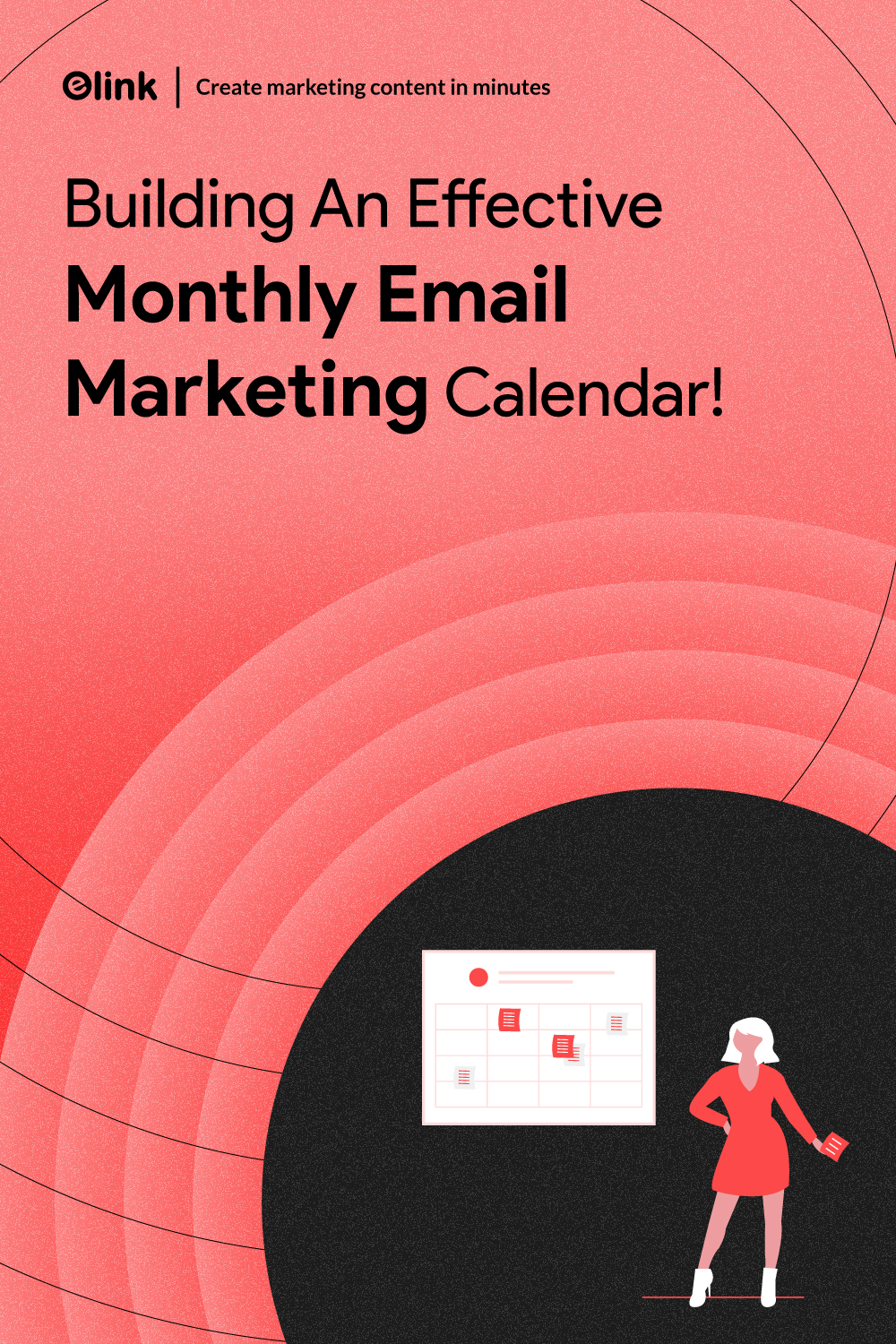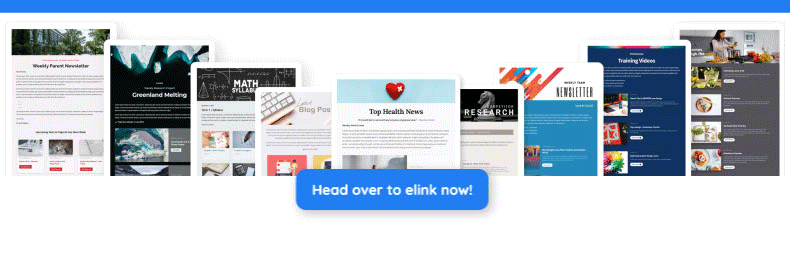“Failing to plan is planning to fail.” — Benjamin Franklin
Well, when it comes to email marketing, it fits perfectly.
If you’re only sending emails whenever you remember or rushing at the last minute to write something, then don’t worry, you are not alone. Many people do this. However, without a plan or strategy, it’s easy to lose track, and you end up sending emails that don’t connect with your audience.
That’s why you need to switch to a monthly content calendar to make the entire email campaign process smoother. A monthly calendar keeps you organized, tells you exactly what and when to send, and gives your emails a clear purpose.
Here, in this blog, we’re going to take you through an easy, beginner-friendly approach to creating a calendar that actually works— one that saves your time, reduces stress, and keeps your audience engaged all month long.
So, are you ready to make email marketing a whole lot easier? Let’s get started.
🚀 Build stunning email newsletters in minutes with Elink.io so you can focus more on the marketing calendar and less on the emails!
What is an Email Marketing Calendar?
Let’s break it down for you.
An email marketing calendar is basically a plan that outlines the emails you’ll send, when you’ll send them, and the reasons behind sending them. That’s it. Easy, isn’t it? With all your emails planned, you’ll save time, stress less, and avoid the “Wait, did we miss sending something this week?” moment.
It’s like having a to-do list just for your emails.
For instance, you could plan:
- A new subscriber welcome email on the 1st of the month
- A product update email on the 10th of the month
- A weekend special offer on the 20th of the month
- And a tips email on the 28th of the month
And the best part of making calendars is that your emails sound more thoughtful and not hastily created. Even your audience starts to expect and look forward to hearing from you. And you remain ahead of the game.
So in brief, an email marketing calendar helps you stay on track with your email plan. It provides you clarity, control, and confidence, week after week.
Now, let’s go further and see what the main components of an email marketing calendar are.
👉 Also read: How to Use Email Marketing for Effective Content Distribution
Essential Components of Email Marketing Calendar
So you’re ready to create your email marketing calendar—but what actually goes into it?
Let’s break it down step-by-step. Imagine your calendar as a useful marketing checklist that keeps you on track. It’s not about dates. It’s about ensuring that you never forget what you’re sending, when you’re sending it, and why.
Here is a quick checklist of what to include:
- Send Date
- Topic or Subject
- Email Goal
- Target Audience (optional)
- Draft Subject Line (optional)
- Status (In Progress, Ready to Send, Scheduled, Not started)
That’s it! You don’t require anything fancy—just a clean, simple structure that enables you to plan confidently. With these elements in hand, your calendar becomes more than just a schedule—it becomes your guide to more innovative and effective email marketing campaigns.
Here’s a Sample Email Marketing Calendar Template:
| Send Date | Email Topic | Email Goal | Audience | Draft Subject Line | Status |
| Aug 5 | Friendship Day Offer | Drive sales | All subscribers | “Celebrate Friendship with 15% Off 👫” | Scheduled ✅ |
| Aug 9 | Weekly Blog Recap | Increase blog traffic | Blog readers segment | “This Week’s Top Reads (Don’t Miss #3!)” | Ready to Send ✔️ |
| Aug 15 | Independence Day Message | Brand connection | All subscribers | “Here’s to Freedom & Fresh Starts 🇮🇳” | In Progress ✍️ |
| Aug 20 | New Product Launch | Promote new product | Interested customers | “Say Hello to Our Latest Launch ✨” | Not Started ❌ |
| Aug 28 | August Round-Up + Offer Reminder | Recap + final push | All subscribers | “Everything You Loved in August + 10% Off” | Not Started ❌ |
Now, let’s dive into how to create a marketing calendar that actually works. Let’s get started.
👉 Also read: Content Marketing Plan: What It Is and How to Create One
How to Create an Effective Email Marketing Calendar
Okay, so we have discussed the main components of an email marketing calendar. Now, we’ll see in detail how to create an effective calendar that actually works. So, if email marketing feels a little out of place for you, then you’re in the right place, as creating an email marketing calendar can sort that out.
Let’s go through it step by step — just as we’re planning it out together.
1. Start With Your Goals (Know Why You’re Sending Emails)
Before we decide what to send, let’s figure out why you’re sending emails in the first place.
So ask yourself these few simple questions:
- Do I want more people on my website?
- Am I trying to sell a product or service?
- Do I want to keep my audience engaged with useful content?
To better understand it, let’s consider the following example. Suppose you’re a bakery business owner. So your objectives might be:
- Promote a weekend cake deal
- Share recipes or baking advice
- Announce a store opening.
Or whatever your goals are. You can do this using an announcement email or a promotional email. Just remember to write them down clearly. They’ll guide your email content.
👉 Also read: Dynamic Email Content: Learn How It Works With Types & Examples!
2. Mark Important Dates First
Now, let’s turn our attention to scheduling emails on specific days to optimize their delivery. For this, you need to schedule important dates in the upcoming months. It can be festivals, holidays, sale days (like black Friday), webinars, events, or more.
Here’s a quick example:
| Date | Event | Email Idea |
| Aug 5 | Friendship Day | “Celebrate with 15% Off for You + a Friend” |
| Aug 15 | Independence Day | “Proud to Be Local: Our Story + Special Freebie” |
✨ Pro Tip: Use color-coded labels or tags in your calendar to quickly spot different types of important dates and events.
3. Decide How Often You’ll Send the Emails
So, you don’t have to send emails daily to be successful. Just start sending the emails and see what works better for you. And if you’re still unsure about what to do, follow this simple rule: If you’re starting out, try sending one email a week. This equates to 4–5 emails a month, be it an outreach, promotional, or interactive one, and they are completely manageable.
🧠 Did You Know?
A study by Campaign Monitor found that once-a-week emails have the highest open and click-through rates across most industries. It’s a sweet spot that keeps your brand visible, without spamming.
4. Plan your Email Topic
Now it’s time to decide the topics of your emails. Decide the topics well in advance and mark them clearly on the calendar. Here are some types of emails and subject lines that you can add when using them:
| Type of Email | Example Subject Line |
| Welcome Email | “Welcome! Here’s What to Expect from Us 🎉” |
| Educational/Helpful | “5 Quick Fixes for a Bad Hair Day” |
| Behind-the-Scenes | “A Look Inside Our Creative Process” |
| Customer Story/Review | “How Priya Doubled Her Sales Using Our Tool” |
| Product Highlight | “Why Our Stainless Bottles Stay Cold All Day” |
| Offer/Discount | “Flash Sale: 20% Off Today Only!” |
You can even mix it up so your emails don’t come across as pushy.
5. Choose the Best Days and Times
Usually, you don’t have to think too hard about it, but timing might help.
Well, studies show that sending emails on Tuesday, Wednesday, and Thursday shows higher open rates. Also, when the emails are sent between 10 AM and 11 AM, there is increased click-through performance compared to other times of the day. So, the preferred day and timing for sending newsletters can be:
- Day: Tuesday, Wednesday, or Thursday
- Time: Late morning (around 10–11 AM)
Additionally, it’s better to track the performance of marketing campaigns to analyze what works. If your audience clicks more on Thursday afternoons, then adapt the future emails accordingly.
💡Read more: 5 Marketing Activities That Will Enhance Business Performance!
6. Review, Tweak, Repeat
Now, once you have created the calendar, review and update it in a timely manner. At the end of the month, take 10 minutes to look back and ask yourself:
- Which emails received the most opens or clicks?
- What subject lines performed best?
- Did I receive any replies or sales from the emails I sent?
And ultimately, use that information to plan better email campaigns next time.
So, creating an email marketing calendar doesn’t have to be overwhelming. All you need is a clear plan, a little time to think, and a mix of content that makes your audience open, read, and click the email.
But let’s be honest, planning is only half the battle. The actual challenge arises in crafting those emails, without wasting hours in formatting and designing. To solve this issue, Elink comes to the rescue. Let’s deep dive into how you can use Elink to craft emails in minutes.
👉 Also read: Top 15 Email Marketing Tips To Revamp Your Marketing Strategy
Make Your Email Calendar Work Smarter with Elink
Now that you have your calendar scheduled—dates sorted, topics scheduled, you may be asking yourself: “Okay… but how do I really put these emails together without hours of design and formatting?”
That’s where Elink.io comes in. And it’s a total game-changer. Elink is a smart tool that makes it easy for you to design and send gorgeous emails with just a few clicks. Rather than struggling with lengthy email drafts, complicated templates, or getting the alt-text just right one by one, Elink allows you to turn your links into stunning, publish-ready monthly newsletters within minutes.
Yes, minutes. Not hours. Now, let’s see how it works so well with your calendar.
Why Elink Works So Well with Your Email Calendar
Let’s connect the dots. When you’ve already planned your emails for the month, Elink makes it super simple to create and send them without the headache. Here’s how it fits perfectly into your routine:
✔️ Convert Links to Newsletters in Minutes: Have links to your new blogs, product updates, YouTube videos, or even useful guides? You simply need to paste the links into Elink, and voilà, a gorgeous newsletter is now ready to send. No more spending hours dragging and dropping the content one by one with Elink.
✔️ Choose From Stunning Templates: Well, Elink provides you with a broad number of professionally designed templates that make your emails look nice and professional. You simply need to insert your content and send it.
✔️ Integration With Your Favorite Email Tools: No issue if you’re already working with Gmail, Mailchimp, Constant Contact, Zapier, or another tool. Elink connects seamlessly with hundreds of leading platforms, allowing you to create in Elink and send using your existing tools.
✔️ Maintain Consistent Branding Without Starting From Scratch: Do you want to schedule weekly or monthly newsletters? With Elink, you just have to save your design as a template. Next time, update the content—such as links and headlines—and send it. It maintains your branding without doing any additional work.
💥Bonus: Here’s the best part: Elink newsletters don’t have to be confined to email. You can share them as web pages, embed them on your blog, or send them via WhatsApp or LinkedIn.
Now, let’s try to understand how Elink can work best with your email calendar with an example: Suppose your calendar looks like this
| Date | Email Topic | Goal |
| Aug 9 | Weekly Blog Recap | Drive traffic |
| Aug 16 | Customer Story + Product Tips | Build trust + value |
| Aug 23 | Flash Sale Announcement | Boost sales |
Here’s how Elink helps:
On August 9, instead of manually writing summaries of each blog, just paste the links into Elink, choose a layout, write a short intro, and hit export. Your email is ready—clean, clickable, and branded. You can do the same for the other emails, and you’ve just knocked out your content for one month in no time.
In a nutshell, your email marketing calendar provides clarity, and Elink provides you with the tools to make it all happen, without stress, delay, or design pain. You simply need to select your links, open Elink, and go from concept to inbox in minutes.
So, Elink + your email calendar = the perfect combo.🚀
💡 Read further:
- AI in Email Marketing: How To Use it, The Benefits & Challenges!
- Email Marketing for Online Courses: A Comprehensive Guide!
Wrapping Up
Email marketing can sometimes feel overwhelming. But when you have a basic calendar set up, everything changes. No more wondering what to send and no more rushing to write emails at the last minute.
With an email calendar, you remain consistent, your content feels more intentional, and your emails actually begin working for you, not against you. And when you combine your calendar with a smart tool like Elink.io, writing those emails becomes quick, easy, and (honestly speaking) even fun.
So, open up a blank calendar, scribble down some email ideas, and give it a try. Start small, be consistent, and see how it changes your email game.
FAQs
Q1. How do newsletter themes help improve engagement?
Newsletter themes give your content a clear focus. When readers know what to expect, like “Motivation Mondays” or “Tech Tip Thursdays,” they’re more likely to open and read your emails regularly. It also makes the marketing plan easier because you’re working around a clear topic instead of starting from scratch every time
Q2. What’s the difference between a newsletter content calendar and a marketing content calendar?
A newsletter content calendar is just for planning your email newsletters—what you’ll send, when you’ll send it, and what each email will include.
A marketing content calendar typically includes a broader range of content. It covers everything—social media posts, blog articles, videos, ads, and emails too.
In short, the Newsletter calendar = email-specific, and the Marketing calendar = all content platforms
Q3. How do I choose the right newsletter topics each month?
You can begin by thinking about what your audience needs or wants. Ask yourself:
- What is currently interesting to them?
- Are there any holidays, events, or trends approaching?
- Do I have any new products, tips, or stories to tell?
You may also glance at your previous emails. Which ones received the highest number of clicks or responses? That’s a hint that your readers liked that topic.
Q4. What are some creative monthly newsletter ideas?
Below are a few engaging and helpful monthly newsletter ideas you can switch up every month:
- Product of the Month – Feature a top-seller or new product
- Useful How-To – Share quick tips or tutorials
- Customer Spotlight – Highlight a satisfied customer’s story
- Special Offer – Provide subscribers with a special promotion or freebie
- Behind-the-Scenes – Reveal what happens in your business
- This Month’s Highlights – Summarize blog posts, events, or news
You can even shuffle things to make your newsletters interesting and fresh!
Keep Reading & Learning 📚
Benefits of Sending out a Gmail Newsletter
8 Reasons Why Your Email Goes To Spam!
The Best Time to Send Newsletters for Maximum Engagement
The Best Font for Emails that Truly Impress
How To Create Marketing Landing Pages in Easy Steps
How to Use an Instagram Newsletter to Skyrocket Your Website Traffic






